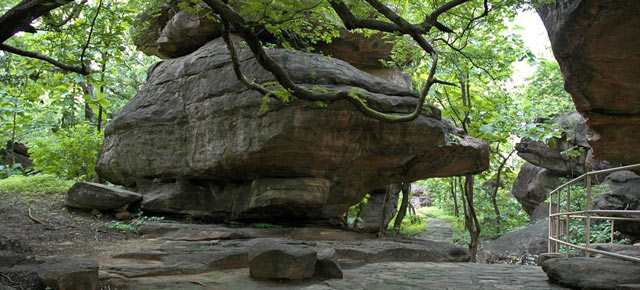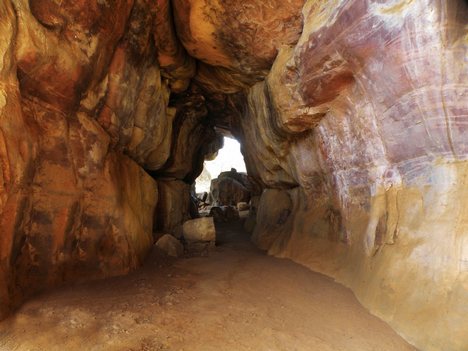Shaded in a thicket of teak and sal, amidst rock-strewn cliffs, the Bhimbetka caves find enlistment as a World Heritage Site by UNESCO. There are enchanting rock paintings here that date back to the Paleolithic, Mesolithic and Neolithic periods adorning these caves. These paintings showcase the everyday life and events of people residing here in the caves.
The rock shelters have been in continuous occupation from an even earlier era, the early Paleolithic period (anywhere from about 500,000 to 100,000years ago, give or take a few). Archaeological evidence indicates that in those days Bhimbetka was an important centre in the stone tool manufacturing industry. An export business seems to have flourished here thousands of years ago! By the time the Indus Valley civilization came into being and flourished, the Bhimbetkans were trading pottery and copper tools with people in neighbouring areas.
A two-hour drive from Bhopal (average roads and unreliable transport make this 50-km journey a long one), this series of rock shelters stands atop a hill, housing some of the oldest cave paintings in India.
The most striking thing about Bhimbetka is that it showcases the manner in which our ancestors lived. While living in these austere rock overhangs (hardly shelters), our Bhimbetkan ancestors were threatened not only by the elements of nature, but also by wild animals, forest fires and possible rival human communities who perceived them as enemies. Millennia of erosion have led to some unique rock formations, such as split-level shelters (similar to modern duplex apartments). This unusual split level shelter was allegedly used as the king’s palace (after all, the community was tribal and monarchy ruled supreme), while another corridor-like high-roofed cave was used as the king’s court. A large sunken cave was even marked to be a graveyard.
These and other sordid and fascinating tales will be recounted with the greatest of conviction by the government-approved guides (they can be hired at a nominal fee, they speak a fair bit of english, and assorted indian languages). These guides follow a fixed path between caves, but the adventurous traveller can explore the place on his own (several caves are left out of the designated route), and discover the true gems of Bhimbetka – the cave paintings. Ranging from crude stick figures to flowing depictions of horses and hunting scenes, these paintings are still preserved in near-pristine condition. Animal figures, humans, hunting, weapons and elaborate rituals seem to have found their way into these Bhimbetkan “drawing rooms”. Several of the original organic dyes are still visible, and the paintings are said to have been made using tree shoots in lieu of a brush. The style, sophistication and subject of each paintings can help ascertain its date of creation, which could be the paleolithic, the mesolithic or a more recent era. The exquisite white horse, for instance, indicates a fairly recent period, while the enormous bison and other animals painted in a vivid red colour seem to be older.
The ideal time to visit Bhimbetka is probably winter, or on an early summer morning. The place becomes hot mid-morning onwards, so do carry a supply of water. Cameras are permitted for a fee. There is no convenient accommodation close to the place, so most travelers prefer to commute from Bhopal.





